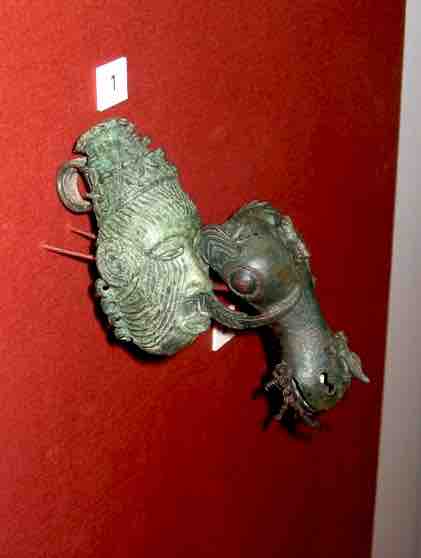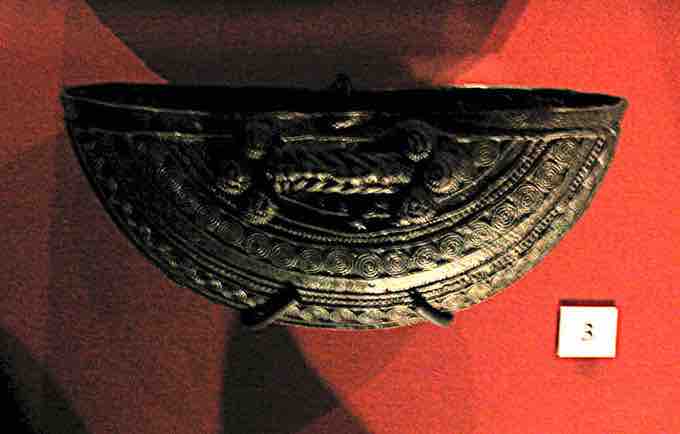Introduction
Igbo-Ukwu, a town of the Igbo people in southeastern Nigeria, is notable for three archaeological sites where excavations have found bronze artifacts from a highly sophisticated metal-working culture dating perhaps to the ninth or tenth century. This was centuries before the production of other known bronzes of the region, making the Igbo culture the earliest known example of a bronze-casting society in the region. The first of the sites, Igbo Isaiah, is a shrine that was uncovered in 1938 by Isaiah Anozie, a local villager who stumbled upon the bronze works while digging beside his home. Subsequent excavations by Thurston Shaw in 1959 resulted in the discovery of two other sites: Igbo Richard, a burial chamber, and Igbo Jonah, thought to be a cache.
Some metal objects were hammered into their current forms, as was the case with many pieces of jewelry. A woman's anklet now housed in the British Museum consists of a central leg tube that extends over an inch beyond the center (approximately 2.75 inches in diameter). Its disk is incised with intricate abstract designs.
Igbo brass anklet
Anklet beaten from a solid brass bar.
Igbo Bronze Art
Most bronze sculptures were made in stages using the lost wax technique, an ancient casting process commonly using wax. Many of the castings integrated small decorative items and designs, showing the artisans' high level of skill. It is believed that some of the bronzes were part of the furniture in the burial chamber of a highly important person, possibly a king. In addition to a variety of ritual vessels, bronze items include pendants, crowns and breastplates, staff ornaments, swords, and fly-whisk handles .

Human and ram's head pendants
The elaborate designs and casting in bronzes such as this one point to the Igbo people's high level of skill.

Igbo Ukwu bronze
A ceremonial vessel made around the ninth century CE.
Other artifacts discovered in the sites include jewelry, ceramics, a corpse adorned in what appears to be regalia, and many assorted copper and iron objects. Tens of thousands of glass beads were also discovered, suggesting a long-distance trading system with places as far away as Egypt, Venice or India.
Other examples of Igbo art
Prior to British colonialism, the Igbo people were a fragmented and diverse group, resulting in artistic styles that are widely varied. Besides the bronze artifacts discovered in the twentieth century, Igbo art is generally known for various types of masquerade masks and outfits symbolizing people, animals or abstract images. The New Yam Festival is an annual cultural festival held at the end of the rainy season in early August to symbolize the conclusion of a harvest and the beginning of the next work cycle. The celebration is a very culturally based occasion, tying individual Igbo communities together as essentially agrarian and dependent on yam.
New Yam Festival
On the right, a participant wears an elaborate mask and headdress with attire made of raffia. The festival in this photograph was organized by Igbo residents of Dublin, Ireland.
Igbo art is also famous for Mbari houses, which are large open-sided square planned shelters containing life-sized mud sculptures. These painted figures--sculpted in the form of deities, animals, legendary creatures, ancestors, officials, craftsmen, and foreigners--are made to appease the earth goddess. The process of building Mbari houses, which often takes years, is regarded as sacred. Therefore, new ones are regularly constructed, while old ones are left to decay.
Construction of a Mbari House
Detail of the upper level and roof.
A unique structure of Igbo culture is the Nsude Pyramids, a group of ten pyramidal clay and mud structures built as temples for the goddess Ala/Uto, who was believed to reside at the top. Everyday houses were made of mud and thatched roofs with bare earth floors with carved design doors. Some houses had elaborate designs both in the interior and exterior, including Uli art designed by Igbo women.